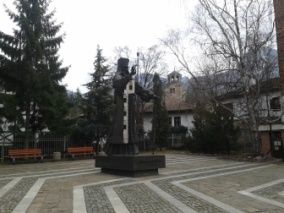

“The Holy Ascension of God” (currently the monument temple “Saint Sofronius Vrachanski”), is the oldest religious building from the city, built in 1848. This is the natural center of the spiritual and of the political life from Vratsa from the middle of the XIXth century, consequently, inseparable associated with one of the most important historical figures and with the events from the period of the Renaissance – Petko Slaveykov, Vasil Levski, the conspirators of the revolt from Vratsa from April commanded by Stoyan Zaimov, the Russian – Turkish war from 1877 – 1878 (they are greeted as mass liberators) and so on.
In the honor of the 250th anniversary of the writer, the diplomat and the political man Saint Sofronie Vrachanski, in 1989 in the temple the Ascension was opened the permanent exhibit of “old Bulgarian art from Vratsa”. This proposes to discover and to outline the distinctive stylistic features of the regional and organic unity between different kinds of art. Its creation has been preceded by an intense activity in the process of collecting by the churches and by the monasteries of the eparchy Vratsa from which there are registered and selected the unique pieces of the iconography, sculptures and liturgical objects from the XVIIth – the XIXth century.
The iconostasis is executed by the famous sculptor Anton Sranisev Debar – it is a remarkable monument of applied art. The icons from the iconostasis are executed by Dimitar Zograf (the brother of Zachary Zograf). One of them worked together with his son Stanislav Dospevski – the first Bulgarian graduate of the Art Academy from Sankt – Petersburg. The oldest icons from the permanent exhibit are dated back from the XVIIth century. And the uncontested peak of the iconographic mastery is the exhibited works of Zachary Zograf.
The art characteristics, the techniques, the specific tools give the reason of talking about an exceptional work of the literary school from Vratsa and about an iconographic style from Vratsa.
